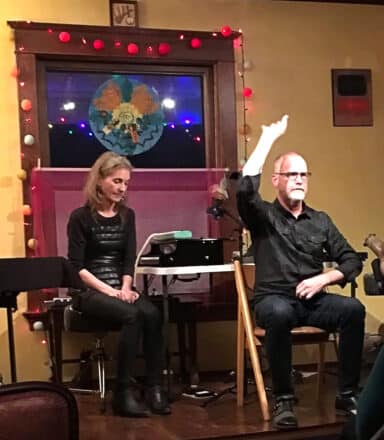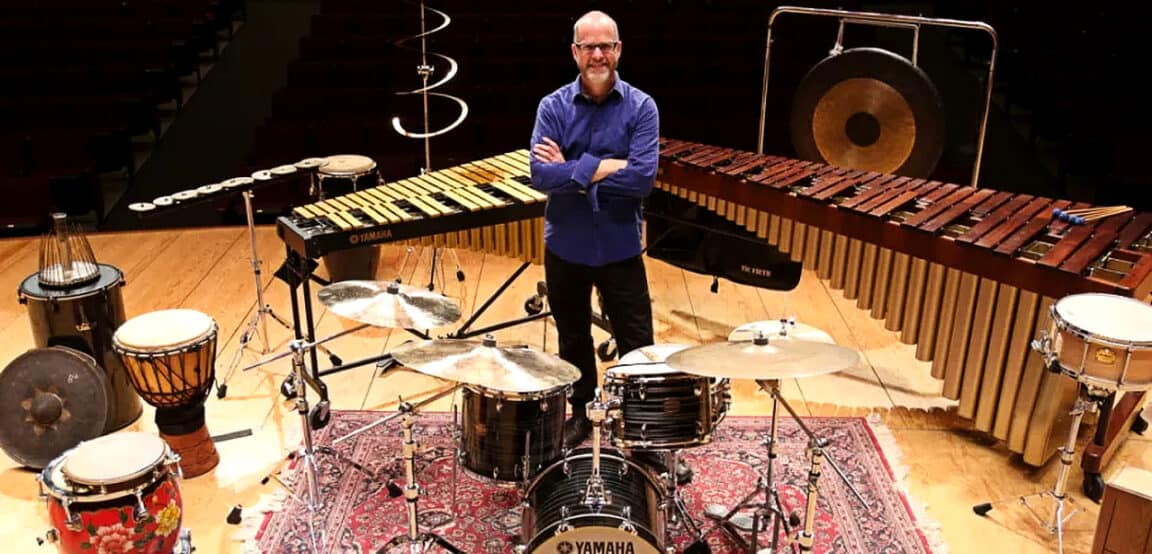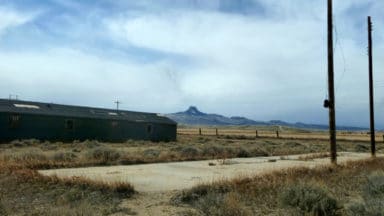The rumor in Southern Oregon is that Terry Longshore can play anything. In addition to innumerable conventional percussion instruments, he also plays buckets, trashcans, sculptures, washing machines, mix-masters, and a variety of plants including the cactus. He also composes and records extensively. Key words to describe his work could be “inter-disciplinary, multi-media, collaborative, co-creative.”
As a Professor of Music at Southern Oregon University, Longshore draws students from all over the world, many of whom have embarked on distinguished careers themselves. He has concertized internationally, and it seems that every week or so he is forming a new duo or group with a new theme. His current ensembles include Left Edge Percussion, Caballito Negro flute and percussion duo, Left Edge (multi-media), and the flamenco groups Flamenco Pacifico and Dúo Flamenco, all based in Southern Oregon and traveling extensively.
Longshore’s groups have performed frequently in Portland as well as Ashland. His duo, Caballito Negro with flutist Tessa Brinckman performed the music-with-poetry piece, Alone |Together, in February 2018 at Abbie Weisenbloom Presents (see Matthew Andrews’ ArtWatch review). Last September, Caballito Negro included flutist Elizabeth McNutt, Portland Percussion Group co-founder Chris Whyte, and SOU graduate percussionist Jared Brown to perform John Luther Adams’s evocative Songbirdsongs, first in Ashland, and later in Portland, and he’s involved in a major Ashland concert this Tuesday featuring new music by Oregon and Mexican composers. Longshore and and I recently met for a chat at ReMix, one of Ashland’s favorite coffee houses.
Global Rhythms
Just the names of his groups (e.g. Caballito Negro and Flamenco Pacifico) indicate the Spanish influence in Longshore’s work. But even greater is the influence of Indian music. He studied at the Ali Akbar College of Music in San Rafael, CA, and later in India. “The Indian rhythmic system is a big part of how I think about rhythm and use it in my compositions,” he says. But he also uses it in the interpretation of other music’s rhythms and in his teaching. Indian music uses a system of vocalization for rhythm, he explains, a set of syllables to learn from and perform, that are adaptable to many different kinds of music. “They help you understand music in a numerical way, and that’s a big part of my rhythmic language.”
Seeing my puzzled expression he explains further:
- They put things into groups using syllables. For example:
- Number one is ta
- Two is ta ka
- Three is ta ki ta
- Four is ta ka di mi
- And then you can build everything from that. So if I wanted to make a phrase of 11, I could do 4 + 4 + 3: ta ka di mi ta ka di mi ta ki ta
- [Say it a few times and you’ll get it!]
“It’s very easy to enunciate,” he continues, “very easy to feel how the groupings make the rhythm swing a certain way.” He then demonstrates a different grouping to achieve the same number by grouping 5 + 6. “Feels different, right?” [It did.] “In Western music, which is written out for us, the composer will often use phrase marks to emphasize certain groups of notes. But you can easily transfer it to the Indian system to get that feeling.”
Connection and Collaboration
Longshore is by nature a collaborator. He does make solo appearances during festivals and with his groups, but although he’s either performing, coaching, or curating concerts every month, sometimes every week, he says he hasn’t done a solo concert in years, and yet he says he just “likes working with people too much.”
Working with other musicians, artists, dancers, poets and writers is what he likes best. He and his wife Jennifer Longshore co-teach an online course in modern music and modern art every summer.
He explains that percussionists are particularly collaborative because composers are always asking them to do, “strange, weird things” like how to make a particular sound. “It’s fun – it’s an adventure, and we enjoy that.” Collaborations often extend to the worlds of visual arts, theater, and dance.
He includes the audience in his definition of collaborators. “When the audience is engaged, there’s an energy that’s just wonderful!” In return, audience members enjoy extra-musical appeal at percussion concerts. Longshore explains that percussion is a very visual art form. The visual interest is a byproduct of creating the sound, by striking or stroking the instruments. “If I make a certain kind of motion that looks like this: [a chopping movement with his arm], people are going to hear a short sound, no matter what the sound is. If I make a motion like this: [a slow, graceful movement of the arm], they would hear a longer sound. If you close your eyes, you might not hear the difference.” This is particularly true, he notes, of playing the marimba.
Longshore’s involvement in the HealthRHYTHMS Group Empowerment program reflects his interest in the use of percussion as a metaphor for communication. The program, developed by therapists to assist group communication, is sponsored by Remo, the world’s largest manufacturer of drumheads, a company that he endorses.
Exotica
There is almost nothing that cannot be made into a musical instrument by Longshore and his colleagues. He recently played a solo piece by John Cage that called for ten instruments to be made out of plant material, eight of which could be chosen by the performer, but the composer specified at least one seed pod rattle and one cactus. “You just look for things that make interesting sounds,” he says. “For example, there’s a weed that grows like crazy around here. It has a gristly, oval cone-like thing that makes an interesting dry sound when you scrape it.”
When Longshore was in graduate school, he and his friend Brett Reed put together a group called Skin & Bones, which lies dormant at the moment. He describes their masterpiece, entitled Mixmaster: “Probably the craziest thing we did was a sculptured instrument that an artist, John Reed, built for us that looks like something out of a Dr. Seuss book. It was made out of a discarded clothes dryer, bicycle parts, and other weird stuff. When you plug it in, it becomes a mixer that powers things, but beautiful sounds could be attached as well. We would climb all over it.”
One of the many compositions that Longshore has premiered in Ashland is another exotic piece, this time with conventional instruments mimicking an exotic subject, the Eiffel Tower. Tower Music by Joseph Bertolozzi is based on the composer’s acoustical study (of bangs and pings all over the famous tower’s various parts), which he distilled to about 2800 “usable” sounds. From the raw recordings Bertolozzi constructed scales and “instrument sets.” The score is written out in standard notation so that it could be performed live by 100 percussionists, which he then arranged for a percussion quintet. Longshore’s group, Left Edge Percussion, premiered the quintet version of the piece in the SOU Recital Hall last November, with the composer present for the event. There is speculation about the possibility of a live performance on the Eiffel Tower for the 2024 Olympics.
Compositions and Commissions
Terry Longshore has composed about 25 works, some co-composed with Tessa Brinckman and other colleagues, many of which he premiered in Ashland, and several have been recorded and played around the world. His solo piece Crash and another called Boom have been played widely, especially in Japan and Germany, where they are often used as a contest pieces. He reports that Crash and Boom have been played on every continent except Antarctica. [Look out, penguins, you’re next…]
“I’m passionate about performing music of contemporary composers,” Longshore states, “but also about commissioning new pieces.” He feels very fortunate to be working with living composers. His list of premieres includes a staggering 90 works. Some of his favorite composers include well-knowns like John Cage and Lou Harrison, (Longshore performed at the latter’s memorial concert at U.C. Berkeley, 2003), and others are actually his friends and co-composers, like Tessa Brinckman and Mark Applebaum.

In the summer of 2016, Longshore participated in the premiere of Michael Gordon’s Natural History, commissioned for the Britt Festival Orchestra to celebrate the 100th anniversary of the National Parks System and performed at Crater Lake. Longshore was responsible for coordinating the 20 brass and saxophone players and 10 percussionists that performed antiphonally, surrounding the audience. These performers augmented the ranks of the orchestra, choir, and Native American drummers. (See a 25-minute PBS documentary about this performance called Symphony for Nature.)
Looking Ahead
This Tuesday, Longshore curates the gala concert celebrating the 50th anniversary of the sister-city relationship between Ashland and Guanajuato, Mexico, which includes five new commissioned works by SOU faculty members and a work by composer Francisco Javier Gonzáles Compeán of the University of Guanajuato. Composer Jared Brown’s work grow, for percussion ensemble, violin, flute, trumpet, and alto saxophone provides a rousing finale.
In Ashland, more concerts are planned for later in April and beyond. Caballito Negro will present a multi-media performance with electronic musician and composer Todd Barton and visual artist Bruce Bayard at the Schneider Museum of Art April 12. Several concerts are planned in conjunction with the 2019 Oregon Fringe Festival, Caballito Negro will present the world premiere of Erik Griswold’s The Timbuktu Manuscripts, the SOU Percussion Ensemble will perform on April 24 at the SOU Center for Visual Arts, and more happenings for the Levity Circus Collective April 26 and 27. Songbirdsongs will be performed again in July, this time at ScienceWorks. Still in the exploratory stage is the possibility of a collaboration with Bang on a Can in New York City. Stay tuned to Longshore’s website to track the schedule of events around the state, nation, and world.
Alice Hardesty is a writer and music enthusiast living in Ashland. Her book of haiku, Walking with Bacho, Four Seasons in Portland, is published by Bacho Press.



